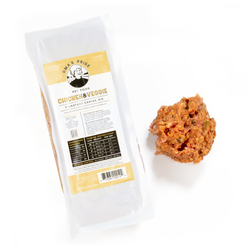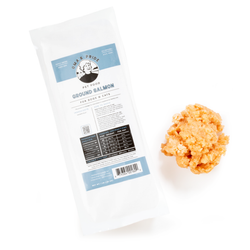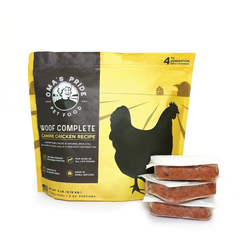The Ultimate Guide to Green Tripe for Dogs
Have you ever eaten tripe...or even seen it?
Maybe you’ve passed by it at the grocery store: white, bleached, and ready for human consumption.
In some countries around the world, like Spain, Italy, and Mexico, tripe is a commonly eaten food. People put it in soups, sausage, and sauces.
While both humans and dogs can eat tripe, how we eat it is entirely different.
Dogs are scavenging carnivores—their ideal diet includes raw meat, organs, and bones. They love devouring tripe, but they need it in its raw (yes, slightly stinky) state.
Today, we will explore green tripe for dogs and why raw feeders love it.
Raw green tripe, or stomach, is beneficial for dogs because it boosts gut health and immunity, contains vital nutrients, and helps special dog populations thrive. You can readily find green tripe online, at a local co-op or farm, or at a natural pet store.
Explore Products
What is tripe?
Put simply, tripe is meat from the stomach of a ruminant animal. People usually think of beef when it comes to tripe, but tripe can also come from lamb, goat, buffalo, sheep, elk, or deer.
Ruminant animals are grass and hay grazers with four different stomach chambers: the rumen, reticulum, omasum, and abomasum. As the name suggests, ruminant animals process food through rumination (a cycle of eating, regurgitating, and chewing) before fully digesting.
Ruminant animals ferment food throughout digestion and create important microbes and fatty acids. They also produce hydrochloric acid and vital digestive enzymes.
This unique digestive system makes tripe a superfood rich in nutrients and beneficial bacteria.
What is green tripe for dogs?
Green tripe simply refers to tripe in its raw form (no bleaching, cooking, or heavy processing). While humans will get sick eating raw tripe, dogs and cats are carnivores, readily able to digest raw meat.
Nutrient composition of green tripe
The Guaranteed Analysis of green beef tripe depends on the blend and brand. Generally, tripe has a moderate amount of protein and fat, low fiber, higher acidic pH, and high moisture content.
For example, the Guaranteed Analysis of Oma’s Pride Ground Green Beef Tripe is 11% protein, 17% fat, 6% fiber, and 69% moisture.
Major benefits of green tripe for dogs
Your dog will love eating tripe, which is beneficial for them. Here we’ll discuss the top reasons to put this nutrient-dense food in your dog’s (or cat’s) bowl.
- Strengthens digestive functioning
- Contains healthy bacteria and boosts immunity
- Filled with essential nutrients
- Promotes weight balance
- Good for dental health
- Supports environmental sustainability

1. Strengthens digestive functioning
If you’re looking for a natural way to support your dog’s digestive system, tripe just might be the answer.
To see why, let’s look at two compartments of a cow’s stomach:
- The rumen. This is the first compartment. It functions as “a fermentation vat. The rumen’s environment favors the growth of microbes. These microbes digest or ferment feed within the rumen and make volatile fatty acids (VFAs)” (source).
- The abomasum. The fourth compartment of a cow’s stomach is rich in digestive enzymes to break down food. These living enzymes, along with partially digested plants, are passed along to dogs when they eat tripe.
Digestive enzymes are critical and perform vital functions in a dog’s body. These enzymes help break down different nutrients: cellulase for fiber, amylase for starches, lipase for fats, and protease for proteins and other nutrients.
Tip! What does a digestive enzyme deficiency look like? Without essential enzymes, your pup may experience diarrhea, bloating, acid reflux, cramping, undigested food in poop, and farting. These signs may indicate that your dog needs digestive help.
Properly functioning enzymes in a dog’s body help to purify the blood, absorb nutrients, eliminate toxins and parasites, and fight viruses.
If your dog struggles to digest and process foods properly, tripe can give their body the extra support it needs.
2. Contains healthy bacteria and boosts immunity
Tripe is also full of healthy bacteria, especially Lactobacillus acidophilus, to support your dog’s gut biome.
Here’s how it works: your dog’s gut needs more positive bacteria than negative ones to thrive. Their systems can fight off illness and process foods better by populating the gut with healthy strains of bacteria, probiotics, and prebiotics.
L. acidophilus is known to “reduce diarrhea and help improve stool quality in dogs. In addition to helping improve digestion, probiotics can also help improve your dog’s mood, fur and skin appearance, and reduce stinky bad breath” (source).
Consider introducing tripe if your dog struggles with constipation, frequent sickness, inflammation, or diarrhea. It can help rebalance the gut to operate optimally.
3. Filled with essential nutrients
There are some unique properties of tripe that make it a powerful health food.
Tripe contains:
- Essential fatty acids. Omega-6, omega-3, linoleic, and linolenic acids give your dog energy and improve metabolism.
- Magnesium. This mineral keeps bones, muscles, and the heart healthy.
- Selenium. Supports your dog’s thyroid and general homeostasis.
- Potassium. This electrolyte ensures muscle, heart, and nerve functionality through electrical charges.
- Vitamins. Includes A, C, D, E, and B-complex (like niacin) vitamins in it.
- Calcium and phosphorus. Tripe contains a balanced 1:1 ratio of calcium and phosphorus for teeth and bone strength.
- Amino acids. Packed with 9 amino acids, including alanine, proline, arginine, glutamic acid, and leucine, which makes it a complete source of protein.
- Zinc. Supports a healthy immune system.
- Copper. Helps keep connective tissue healthy, absorbs iron, and produces red blood cells.
- Choline. Detoxifies the liver, supports brain function, and enhances muscle performance.
- Chlorophyll. Detoxifies and replenishes blood and is linked to cancer prevention.
- Iron. Supplies oxygen to your dog’s system.
- Healthy fats. Unsaturated fats in tripe boost healthy cholesterol and help the heart.
4. Promotes weight balance
Tripe can help balance your dog’s weight because it is very low in carbohydrates. While dogs can process carbs, they are not their best fuel source. A high-carb diet for dogs can lead to chronic inflammation and weight gain.
Your dog can maintain a healthy weight with biologically appropriate, nutrient-rich foods like tripe.
Tip! Tripe is very rich and higher in calories. Be careful to feed in moderate proportions and watch caloric intake, or it could lead to unwanted weight gain.
5. Good for dental health
Tripe can be served in larger dehydrated or freeze-dried strips for dogs to chew on. Like raw meaty bones, tripe strips act as natural toothbrushes to clean dogs' teeth. Additionally, the natural motion of chewing and tearing strengthens the jaw and mouth muscles.
While chewing, dogs scrape off tartar and plaque from their teeth. This can help prevent dental disease, infection, gingivitis, and more.
6. Supports environmental sustainability
In certain situations, tripe meat is discarded because it is a less desirable animal part. By feeding tripe, you can reduce your environmental footprint by promoting the use of the whole animal. Your dog will ensure that nothing goes to waste!
Special dog populations and tripe
While most dogs benefit from eating tripe, there are certain populations that it is especially good for:
- Senior pets. Some older dogs begin to lose their appetites as they age. Tripe’s very strong odor can interest senior dogs who may otherwise be uninterested in food.
- Picky eaters. If your dog is uninterested in their food, consider adding some tripe to their bowl. The strong aroma can pique the interest of dogs refusing to eat other foods.
- New mothers. While nursing, new dog mothers require extra nutritional support to prevent malnourishment. Tripe is a superfood packed with nutrients like calcium and fatty acids to give new moms strength.
- Post-surgery dogs. After some surgeries, dogs can feel uncomfortable and nauseous. If they can eat a little tripe, it can give them strength and essential vitamins and minerals to recover faster.
- Dogs that eat poop. Some dogs eat poop (called coprophagia) because their body craves more digestive enzymes. By eating tripe, these dogs will get the digestive support they need…without the gross habit.
- Dogs with kidney disease and renal failure. Tripe is a safe food for dogs with kidney problems because of its lower phosphorus content, high moisture level, and inclusion of high-quality protein with fatty acids.
- Dogs with food sensitivities or allergies. Most dogs do not react allergically to tripe because it is white meat with low myoglobin levels. However, if you are concerned, start slowly with one protein (beef) and move to a different protein (like lamb) if your dog reacts poorly.
- Dogs with EPI (exocrine pancreatic insufficiency). EPI occurs when the pancreas doesn’t produce enough enzymes to digest food. While tripe cannot cure EPI, it can provide extra digestive enzymes to strengthen the system. Some owners have seen success with feeding a pancreatic enzyme supplement before eating tripe to help the body absorb nutrients properly.

Green tripe considerations
While there are many benefits of tripe, there are also a few things to consider before purchasing.
First, green tripe is very stinky to humans. The strong odor is off-putting to some people, but the smell makes your dog love it! When handling tripe, thoroughly wash your hands and surfaces to ensure the stink doesn't stay.
Second, tripe is richer and fattier. If your dog has never eaten it, consider starting slow to avoid digestive upset and diarrhea.
Third, tripe is intended for supplemental feeding only. Dogs still require more bone content than tripe provides for a balanced diet, so it should not be fed exclusively. While dogs can eat tripe daily to meet muscle meat requirements, other items should also be added to the diet.
Types of tripe–what is best?
Tripe is sold in different forms. Let’s look at the pros and cons of each kind:
| Type | Pros | Cons |
|---|---|---|
| Raw, ground, and frozen | Not heat processed, so it contains all nutrients and live enzymes. Also offered in convenient portion packs. | Must be frozen or refrigerated before serving (travel could be an issue). |
| Freeze-dried | It is also not heat-processed, so its nutrients remain intact. Convenient for travel because it can stay at room temperature. | Freeze-dried foods are typically more expensive than frozen. |
| Air-dried | No heat processing ensures nutrients are preserved. Beef tripe sticks are made using this process, which dogs can chew on for good dental health. | Like freeze-dried, air-dried processing tends to be expensive. |
| Dehydrated | Very low heat processing retains most nutrients. | Some nutrients and enzymes are lost due to low heat processing. |
| Canned | Convenient and shelf-stable. | Canned tripe is typically cooked (heat-processed) and preserved with additional thickeners or gums. These added ingredients make it the least healthy form for dogs. |
Where to find green tripe for your dog
Beginning your search for the perfect tripe can be overwhelming. But we’re here to make it simple.
First, let’s talk about where you shouldn’t look. As we mentioned before, supermarket tripe is bleached and processed for human consumption. So, you do not want to source your dog’s food from here because it lacks live enzymes and raw nutritional value.
Lucky for you, there are a ton of other options!
- Online. Many online stores (like Oma’s Pride) sell tripe that can be delivered straight to your door. Green tripe created exclusively for dogs is safely packaged and contains all the benefits of raw tripe goodness.
- Local pet store. If you live in a place with natural pet stores that sell raw dog food, you can probably find tripe sold in-store. They may stock from companies that don’t sell online, and you can try a few different options to see what you prefer.
- Local butcher. Consider finding a butcher in your area who sells tripe. While some butchers may be unwilling to process it for canine consumption, others might be. Be sure to do your research to ensure that the butcher’s sourcing is natural, ethical, and from grass-fed animals.
- Local co-op or small farm. Raw food co-ops can connect you with sources to purchase high-quality tripe in your area. While these co-ops might have a membership fee, they can be a great resource for raw feeders. Farms or small meat processors in your area may also be willing to sell you tripe, especially if it will be wasted otherwise.
How to prepare and serve green tripe
The amount and frequency of feeding will be determined by the form you purchase it in (raw, freeze-dried, or another).
Although tripe can be fed daily to meet muscle meat requirements, it's very rich and nutrient-dense. To prevent digestive issues, limit tripe to about 15-20% of the total daily muscle meat in the diet.
Here are a few serving ideas to get you started:
- Use #1: Serve it as a treat. You can use air-dried tripe sticks for recreational chewing or freeze-dried bites as a training treat. Both activities provide vital mental stimulation for your pup.
- Use #2: Serve it raw. When serving raw tripe that was initially frozen, thaw it in the refrigerator for about 24 hours before serving. Most dogs will devour tripe by itself, but you can also add a portion to a larger meal.
- Use #3: Use it as a topper. Sprinkle a bit on top of meals for a great nutritional bonus! Tripe also makes food exciting for picky eaters. Put some tripe on top of a meal to get your dog to eat the entire meal.
Bonus: cats and green tripe
Did you know that cats can also eat tripe? While they may not love the smell as much as dogs, they can get the same nutritional benefits from tripe as dogs.
Final thoughts
Green tripe for dogs (and cats!) is an amazing way to support your pet’s health. From digestive aid to immunity-boosting properties, the benefits of tripe are hard to beat. Whether you can feed a lot or a little tripe, your furry friend will thank you immensely.
Leave a comment
Your email address will not be published. Required fields are marked with *













